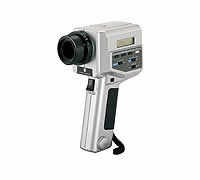Konica Minolta LS-100/LS-110 Luminance Meters
Konica Minolta Updated: 2008-12-24 RSS
High precision Luminance-Meter with small angle
The spot luminance meters LS-100 and LS-110, categorized in the upper range of the DIN quality class B, are among the best hand meters on the market. The SLR (single lens reflex) optical system allows precise targeting and ensures that the viewfinder shows the exact area to be measured, even at very short distances. This makes even precise focussing very easy. In addition to the measurement field and the measurement environment, the viewfinder also shows the measured luminance value. The pistol grip makes handling of the unit very secure. We have given special attention to minimize flare and to give precise V(λ) correlation (CIE relative photopic luminosity curve). With the help of a close-up lens, areas as small as 0.4mm diameter can be measured.
Areas of application
Light sources of all types can be measured with the LS, for example signal, traffic lights, airport lighting, lamps, LED's, picture tubes, etc., just about anything that emits light. Now you can, for example, guarantee minimum brightness, exchange lamps that are too dark early enough, build quality assurance into the production of lamps, or check indirectly illuminated objects like movie screens.
Background knowledge (LS-100)
The unit of illumination L equals candelas per square metre (cd/m2), and within this is also the source of this measurement, namely the light strength I emitted per surface area unit A in the angle ε : L= I/(A cos(ε))
Basically, luminance specifies the brightness of a luminous surface and/or a light source. The sun has an luminance of about 1 billion cd/m2, fluorescent lamps about 10,000 cd/m2. In some countries the unit foot lambert (ftl) is also used to express illuminance, which the LS can display if required. 1 ftl = (1/π cd/ft2 = 3,426 cd/m2
With its 1° angle of measurement, the LS-100 represents the standard spot luminance meter. Its measurement range starts at 0.001 cd/m2 and is therefore able to meter extremely dark surfaces. With the large 9° field of view and the measured value displayed on an LCD in the viewfinder, the object of measurement can be controlled at all times without taking the LS-100 from your eye. A second LCD display on the exterior of the meter, plus a tripod screw port, allows the user to take measurements without looking through the viewfinder. A neutral density eyepiece filter is included to allow the user to measure strong light sources using the viewfinder.
Besides the measurement of absolute luminance, the LS can also display relative luminance as a percentage of a defined standard (target). With this function, the brightness distribution on large surfaces such as monitors can be rapidly ascertained. The peak luminance value can also be displayed on command, useful when measuring flickering light sources such as fluorescents.
In order to further improve the already negligible deviation from the targets of the CIE relative photopic luminosity curve for certain light sources, the LS-100 offers the option of user-calibration.
Background knowledge (LS-110)
The unit of illumination L equals candelas per square metre (cd/m2), and within this is also the source of this measurement, namely the light strength I emitted per surface area unit A in the angle ε : L= I/(A cos(ε))
Basically, luminance specifies the brightness of a luminous surface and/or a light source.The sun has an luminance of about 1 billion cd/m2, fluorescent lamps about 10,000 cd/m2. In some countries the unit foot lambert (ftl) is also used to express illuminance, which the LS can display if required. 1 ftl = (1/π cd/ft2 = 3,426 cd/m2
The narrow angle of measurement of only 1/3° ensures the LS-110 is perfect for very small luminous surfaces and/or measurements in small steradians. With the help of the close-up lens VA-110, areas as small as 0.4 mm diameter can be measured. The measurement range is very large at 0.01 to 999,900 cd/m2 and covers a wide range of uses. All other features and technical specifications correspond to those of the LS-100.
User Manual
Related Manuals
Konica Minolta Multi Gloss 268 Glossmeter
Konica Minolta CL-200 Incident Color Meter
Konica Minolta UM-10 UV Radiometer
Konica Minolta CA-210 Display Color Analyzer
Konica Minolta CA-100Plus CRT Color Analyzer
Konica Minolta CA-2000 2D Color Analyzer
Konica Minolta CS-2000 Spectroradiometer
Konica Minolta CS-2000A Spectroradiometer
Konica Minolta CS-200 Luminance Color Meters
Konica Minolta CS-100A Luminance Color Meter
Konica Minolta RANGE7 Non-contact 3D Digitizer
Konica Minolta VIVID 9i Non-contact 3D Digitizer